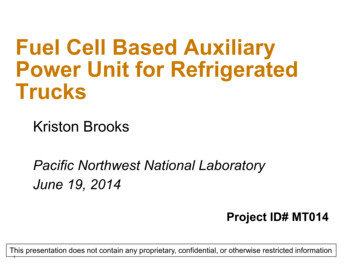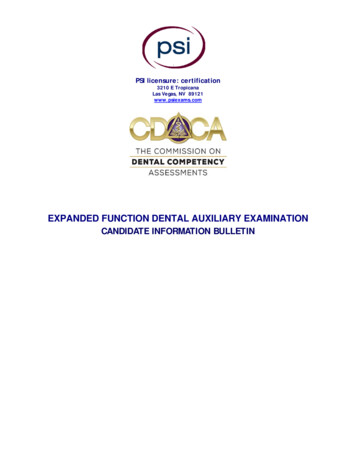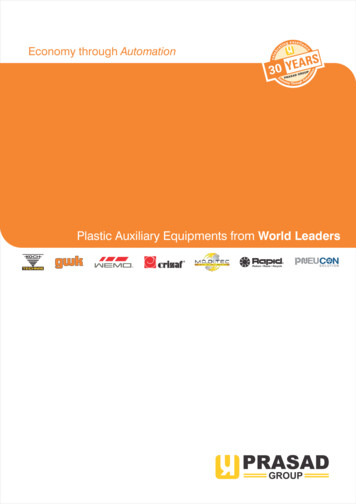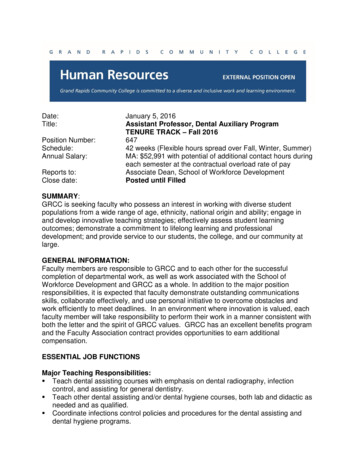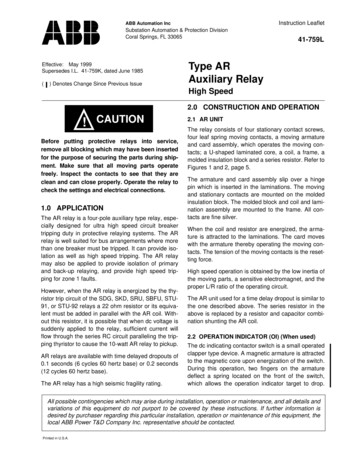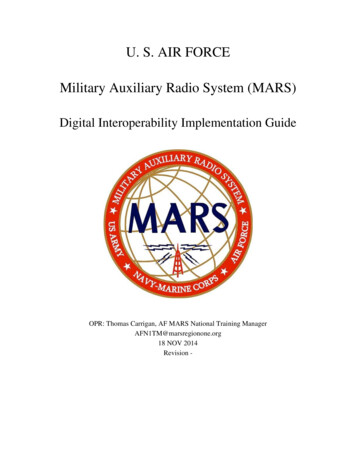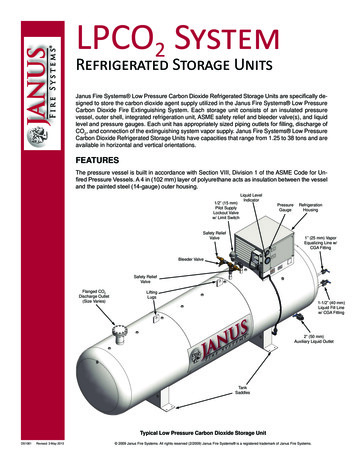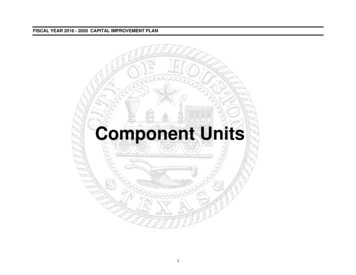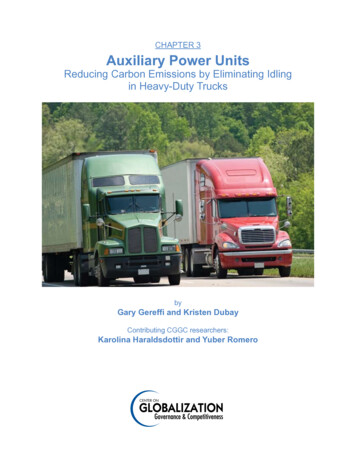
Transcription
Chapter 3Auxiliary Power UnitsReducing Carbon Emissions by Eliminating Idlingin Heavy-Duty TrucksbyGary Gereffi and Kristen DubayContributing CGGC researchers:Karolina Haraldsdottir and Yuber Romero
SummaryThe auxiliary power unit (APU) offers long-haul truck drivers amenities like air conditioningduring driving breaks while eliminating the need to idle the engine. This technology couldhelp eliminate 11 million tons of carbon dioxide emissions from truck idling in the United Stateseach year (SmartWay Transportation Partnership, 2004). The market penetration for APUs in theUnited States is about 5% (Bubbosh, 2008). Thus, APU technology has significant potential toreduce future carbon emissions, and it constitutes one of the U.S. Environmental ProtectionAgency (EPA) SmartWay Transport Partnership strategies. In addition to environmental benefits,current APUs save on average 8% in fuel costs each year, according to the EPA. High upfrontcosts (approximately 7,000- 9,000 per unit) limit APU penetration. To assist with theexpansion of idle reduction technologies, the EPA has partnered with the Small BusinessAdministration to set up attractive loan packages for trucking companies that implementSmartWay strategies, such as the use of APUs.Expanded production of APUs would create economic opportunity at all stages of the valuechain by increasing purchases from material and component suppliers, many of which are U.S.based. A secondary economic impact of expanded APU production and sales could be increaseddemand for APU installation and service providers across the country. Additional value chainopportunities will likely come when APU technology is integrated as a component in tractormanufacturing rather than being an aftermarket product. If this occurs, APU manufacturers willbecome component suppliers to tractor manufacturers instead of to retailers who sell to end users.This would likely realign the supply of jobs along the value chain, with more emphasis on manufacturing and service work and away from retail and installation jobs. It is possible that verticalintegration could reduce the cost barriers of adding APUs as an aftermarket product. Thus, thesechanges could have positive U.S. job implications if they result in more widespread use of APUson tractors, which would require increased production and a greater need for APU service work.Figure 3-1. Auxiliary Power UnitALTERNATORENGINEAIR FILTERA/C COMPRESSOREXHAUSTGENERATORBELT TENSIONERReprinted with permission from Black Rock Systems, http://www.blackrockapu.com38
IntroductionThere are five major types of idling reduction technologies: cab and block heaters, automaticengine start-stop controls, battery-powered air conditioning systems, on-and-off truckelectrification, and auxiliary power units. While not the most commonly used idling reductiontechnology, APUs enable truck drivers to access the full range of cabin comforts (e.g., heating,air conditioning, electricity for personal devices such as televisions and cooking devices) withoutrestricting where the truck must stop. Other idle reduction technologies either dictate stoppinglocations or provide fewer amenities.The current market penetration rate for all idle reduction technologies is estimated at 36% of thesleeper cab market (American Transportation Research Institute, 2006). Approximately 12% ofdrivers with idle reduction technologies are estimated to use APUs. Fuel-operated heaters, whichprovide heat to the cabin when the engine is off, are more common, with a penetration rate ofapproximately 32% of that population (American Transportation Research Institute, 2006). Fueloperated heaters do not offer the full range of cabin comforts provided by an APU, but theirpenetration rate is higher because of the lower up-front costs. The low penetration of APUsindicates untapped manufacturing and sales potential for this market, but it also illustrates thedifficulty in convincing fleet owners and independent truck owner-operators to purchase andinstall APUs. Some barriers include the high initial costs and lack of awareness of true idlingcosts. These may be overcome by rising fuel prices. Other barriers include a 12% federal excisetax and APU system durability concerns (Bubbosh, 2008; Lutsey et al., 2003). However, thereis an effort to address the excise tax, and a survey by the American Transportation ResearchInstitute found that, in general, drivers are satisfied with system performance and indicate thehigh initial investment to be the major deterrent (American Transportation Research Institute,2006).Auxiliary Power Unit Value ChainThe auxiliary power unit has more than 43 components, and the value chain incorporates fivestages: materials, components, finished product, distribution (including installation and technicalsupport), and end use. Figure 3-2 illustrates this value chain, and a more complete value chainwith illustrative company information appears at the end of the chapter. Many of the companiesinvolved across the APU value chain are located in the United States. Expanded production ofAPUs could create economic opportunity at all stages of the value chain.MaterialsThe major raw materials used in APU component manufacturing are aluminum, copper, plastic,steel, zinc, brass, and fiberglass. Other raw materials include cotton gauze, carbon, and filtercloth. The United States is the world’s largest producer of plastic and brass (United NationsIndustrial Development Organization, 2007 and NBMmetals.com, 2007). The top U.S. producingcompanies are Dow Chemical Company and E.I. du Pont De Nemours & Company for plastics,and National Bronze & Metals and Allied Brass for brass (Hoover’s Inc., 2008b, 2008c; andNBMmetals.com, 2007). The United States also supplies a significant portion of the other rawmaterials with the exception of zinc. The major producers for iron ore and steel are ClevelandCliffs and U.S. Steel (Cleveland Cliffs, 2008; U.S. Steel, 2008), and the major producers ofaluminum are Alcoa, Inc. and A.M. Castle (Hoover’s Inc., 2008a). The market strength of andproximity between suppliers of raw materials and U.S. components and APU manufacturers is anopportunity to strengthen domestic job opportunities within the value chain.39
Figure 3-2. Simplified Auxiliary Power Unit Value ChainMaterialsComponentsDiesel engineSteelAluminumCopperOthercomponentsBatteries forhybrid or electricAPUPlasticTop APUmanufacturersHVAC unitAlternatorZinc coatedplatesFinishedProductOther ingAPUsDistributionDealersEnd UseTrucking andfreightcompaniesWholesalersIndependenttruck driversInstallationand rassCarbonCotton gauzeFiberglassFilter clothR&DThere are a few manufacturers and smalldevelopers designing new fuel, hybrid, andall-electric APUsSource: CGGC, based on company annual reports, individual interviews, and company websites.ComponentsDiesel APUs have three major components: the alternator; the engine (usually 2- or 3-cylinder);and the heating, ventilating, and air conditioning (HVAC) system. The main components of thealternator include the bearings, brushes, housing, rectifier, regulator, rotor, and stator. The maincomponents of the diesel engine include the integrated rotor, stator generator, block, bearings,and cylinder. The main HVAC system components include the compressor, refrigerant,evaporator, and condenser. The major suppliers of engines and HVAC systems are listed inTable 3-1. Many APU engines are manufactured outside the United States, but companyinterviews indicate that a significant proportion of other component manufacturing and assemblyis completed here. For example, the Thermo King TriPac APU has a Yanmar engine made inJapan, but enough of the remaining APU manufacturing and assembly is done in the UnitedStates that the APU meets classification as a U.S.-made product (Kampf, 2008).40
Relatively new to the market are hybrid and electric APUs, for which batteries and an invertedcharger are important components in the value chain. The components of an all-electric APU arethe HVAC system, batteries, the alternator, and an inverted charger.Table 3-1. Illustrative APU Engine and HVAC System ManufacturersAPU inePerkinsEngineYanmarEngine & HVAC systemCaterpillarEngine & HVAC systemCumminsHVAC systemDometic Environmental Corp.HVAC systemMobile ThermosystemsHVAC systemThermo KingLocationJapanJapan & IllinoisJapan & Source: CGGC, based on company annual reports, individual interviews, and company websites.APU ManufacturingThermo King is the leading manufacturer of APUs with more than 50% of APU sales (Kampf,2008). Other market leaders include Rigmaster Power (15%-20% market share), Black RockSystems (10%), and Teleflex (which sells its APU through Carrier Transicold retailers). Anumber of other companies offer APUs, but these smaller companies often focus on assemblyrather than component innovation, and they outsource the manufacturing of parts. The smallerAPU companies have limited market share and move frequently into and out of the APU market.A more inclusive list of APU manufacturing companies and their headquarter cities and statesappears in Table 3-2.The APU manufacturing companies have a broad geographic distribution across the UnitedStates (see Figure 3-4). The majority are small companies with fewer than 100 employees. Thesmallest firms have limited distribution networks and operate in local markets selling andinstalling the APUs on location. By contrast, the big companies have multi-state distribution,installation, and service networks. Three of the most common APUs on the market are the TriPac(Thermo King Co.), the RigMaster Power (RigMaster Power, Inc.), and the Black Rock (BlackRock Systems) (Bosch, 2008; Landstar System, Inc., 2008).41
Figure 3-3. Auxiliary Power Unit Materials and Corresponding ComponentsComponentsMaterialsAlternatorSteel- Bearings- Brushes- Housing- Rectifier- Regulator- Rotor- StatorPlasticCopperDiesel engine- Bearings- Block- Cylinder- Cylinder wall- Integrated rotor- Motor home- Oil pumping- Piston- Stator generatorAluminumCotton gauzeHVAC unit- Air filter- Aluminum housing- Compressor- Condenser- Copper pipe- Contactor- Dehumidifier- Electric engine- Evaporator- Fan- Heat pump- Radiator- Thermostats- Refrigerant- WiringCarbonFilter clothBrassZinc coated platesOther componentsFiberglass- APU cover- Battery charger- Belt transmission- Converter- Electronic control modules- Filters, air and oil- Generator- APU mount- Muffler- Radiator- Receptacles- WiringSource: CGGC, based on company annual reports, individual interviews, and company websites.42
Table 3-2. Auxiliary Power Unit Manufacturers, 2007CompanyAuxiliary Power Dynamics, LLCBlack Rock Systems, LLC*Comfort MasterCumminsDaimler Trucks North America,LLCDouble Eagle IndustriesEnertek CorporationFlorida Manufacturing GroupFlying J, Inc.Kohler Power Systems (MobileDiv.)Pony Pack, Inc.Rigmaster Power, Inc.*SCS/Frigette CorporationStar Class, Inc.Teleflex Power Systems*Temco Metal Products*Thermo King Company*Tridako Energy SystemsAPU NameWillis Auxiliary Power SystemBlack Rock; Black Rock EvolutionComfort MasterComfortGuard SystemNITE anti-idling system; RestSmartsystemGenPacInfini-GenIdleBusterCab Comfort SystemHeadquartersSparks, NVReno, NVWhittier, CAMinneapolis, MNKohler 3APU; Kohler 7APUKohler, WIPony PackRigMaster PowerAlliance APUGen-StarComfortProIdle Solutions APUTriPacPowerCubeAlbuquerque, NMOlathe, KSFort Worth, TXNew Castle, PACanadaClackamas, ORBloomington, MNAlliance, NEPortland, ORShipshewana, INBeaverton, OROdessa, FLOgden, UT*Indicates top APU manufacturing companiesSource: CGGC, based on company annual reports, individual interviews, and company websites.Some heavy-duty truck manufacturers also play a role in manufacturing idling reductiontechnologies like APUs. For example, Daimler Trucks North America owns Alliance Parts,which manufactures the Alliance APU. The Alliance APU is installed in Daimler trucks andalso commercialized in the market. Navistar installs Maxxpower APUs in some of its trucks,and Mack Trucks, Inc. is another company installing APU technology. The fact that truckmanufacturers are investing in these technologies indicates recognition of the demand for idlingreduction by fleet and independent truck owners. In fact, this demand seems to be increasing,and APU technology appears to be going in the direction of vertical integration, with factoryinstallation of APUs becoming more common than after-market sales.43
Figure 3-4. Geographic Distribution of U.S. Companies ManufacturingAuxiliary Power Units and Engine and HVAC System UTCANYMOOKNMKYVAMARICTNJDEMDNCTNSCARLAAPU ManufacturersWVILMSTXOHNHALGAFLU.S. APU ManufacturersU.S. APU Engine ManufacturersU.S. APU HVAC ManufacturersSource: CGGC, based on company annual reports, individual interviews, and company websites.DistributionOver 2,300 companies across the country provide APU retail, installation, and maintenanceservices. Most of these vendors are dealers, service centers, and installation centers. Thesevendors are generally small businesses with fewer than 30 employees. The APU dealer/retailnetwork is well distributed across the country, with a minimum of six in the District of Columbiaand a maximum of 129 in Texas. Many of these actors in the value chain employ workers withmechanical skills. Greater APU use in long-haul trucks has the potential to increase the need forservice jobs nationwide.End UseThe final stage of the value chain refers to consumers of APU technologies, including freightcompanies, independent truck drivers, and truck manufacturing companies. There are about41,000 general freight trucking companies in the United States. Approximately 5% are largecompanies with more than 100 driv
APU companies have limited market share and move frequently into and out of the APU market. A more inclusive list of APU manufacturing companies and their headquarter cities and states appears in Table 3-2. The APU manufacturing companies have a broad geographic distribution across the United States (see Figure 3-4). The majority are small companies with fewer than 100 employees. The smallest .
